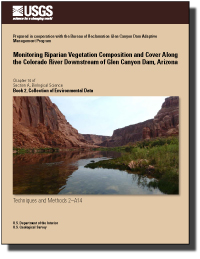Monitoring riparian-vegetation composition and cover along the Colorado River downstream of Glen Canyon Dam, Arizona
Links
- Document: Report (5.5 MB pdf)
- Download citation as: RIS | Dublin Core
Abstract
Vegetation in the riparian zone (the area immediately adjacent to streams, such as stream banks) along the Colorado River downstream of Glen Canyon Dam, Arizona, supports many ecosystem and societal functions. In both Glen Canyon and Grand Canyon, this ecosystem has changed over time in response to flow alterations, invasive species, and recreational use. Riparian-vegetation cover and composition are likely to continue to change as these pressures persist and new ones emerge. Because this system is a valuable resource that is known to change in response to flow regime and other disturbances, a long-term monitoring protocol has been designed with three primary objectives:
- Annually measure and summarize the status (composition and cover) of native and non-native vascular-plant species within the riparian zone of the Colorado River between Glen Canyon Dam and Lake Mead.
- At 5-year intervals, assess change in vegetation composition and cover in the riparian zone, as related to geomorphic setting and dam operations, particularly flow regime.
- Collect data in a manner that can be used by multiple stakeholders, particularly the basinwide monitoring program overseen by the National Park Service’s Northern Colorado Plateau Network Inventory and Monitoring program.
A protocol for the long-term monitoring of riparian vegetation is described in detail and standard operating procedures are included herein for all tasks. Visual estimates of foliar and ground covers are collected in conjunction with environmental measurements to assess correlations of foliar cover with abiotic and flow variables. Sample quadrats are stratified by frequency of inundation, geomorphic feature, and by river segment to account for differences in vegetation type. Photographs of sites are also taken to illustrate qualitative characteristics of the site at the time of sampling. Procedures for field preparation, generating random samples, data collection, data management, collecting and managing unknown species collections, and reporting are also described. Although this protocol is intended to be consistent over the long-term, procedures for minor and major revisions to the protocol are also outlined.
Suggested Citation
Palmquist, E.C., Ralston, B.E., Sarr, D.A., and Johnson, T.C., 2018, Monitoring riparian-vegetation composition and cover along the Colorado River downstream of Glen Canyon Dam, Arizona: U.S. Geological Survey Techniques and Methods, book 2, chap. A14, 65 p., https://doi.org/10.3133/tm2A14.
ISSN: 2328-7055 (online)
Study Area
Table of Contents
- Executive Summary
- Background and Objectives
- Sampling Design
- Field Methods
- Data Management, Analysis, and Reporting
- Personnel Requirements and Training
- List of Standard Operating Procedures
- References Cited
- Appendix 1—Standard Operating Procedures
- Appendix 2—Fixed Sites
- Appendix 3—Datasheets
- Appendix 4—Example Random Sampling Schedule
| Publication type | Report |
|---|---|
| Publication Subtype | USGS Numbered Series |
| Title | Monitoring riparian-vegetation composition and cover along the Colorado River downstream of Glen Canyon Dam, Arizona |
| Series title | Techniques and Methods |
| Series number | 2-A14 |
| DOI | 10.3133/tm2A14 |
| Publication Date | June 05, 2018 |
| Year Published | 2018 |
| Language | English |
| Publisher | U.S. Geological Survey |
| Publisher location | Reston, VA |
| Contributing office(s) | Southwest Biological Science Center |
| Description | ix, 65 p. |
| Larger Work Type | Report |
| Larger Work Subtype | USGS Numbered Series |
| Larger Work Title | Section A: Biological science in Book 2: Collection of environmental data |
| Public Comments | This report is Chapter 14 of Section A: Biological science in Book 2: Collection of environmental data. |
| Country | United States |
| State | Arizona |
| Other Geospatial | Colorado River |
| Online Only (Y/N) | Y |


